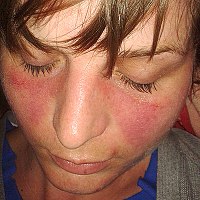
Photo from wikipedia
phigus foliaceus. The authors evaluated 2080 SNPs located in lncRNA in 229 patients with 6681 controls. The SNP rs7144332 at AL110292.1 on chromosome 14 was shown to be the most… Click to show full abstract
phigus foliaceus. The authors evaluated 2080 SNPs located in lncRNA in 229 patients with 6681 controls. The SNP rs7144332 at AL110292.1 on chromosome 14 was shown to be the most significantly associated with endemic pemphigus foliaceus, with five other SNPs suggestive of an association. As these lncRNA are not well characterized, the authors followed up on these findings by performing in silico analysis of these SNPs to determine their impact on transcript, secondary structure and microRNA–lncRNA interactions. Their analyses predicted rs7144332 to alter transcription factors motifs for EOMES, Ik-1, Ik-2 and RBP-J kappa, with several interactions among the other studied SNPs. As such, this study demonstrates a novel, human leucocyte antigen (HLA)-independent genetic risk factor for development of endemic pemphigus foliaceus that provides an exciting new direction in the study of autoimmune blister disease pathogenesis. lncRNA represent the largest class of noncoding RNA. Once considered transcriptional noise, lncRNA have been shown to have numerous regulatory roles including chromatin modulation and remodelling, genomic imprinting, post-transcriptional regulation, microRNA sequestering, Staufen-mediated mRNA decay, natural antisense transcript formation, protein activity, nucleolar remodelling, centromere assembly, as well as many other cellular processes. lncRNA can also modulate immune function. Whole transcriptome analysis using next-generation sequencing has revolutionized our ability to identify and study lncRNAs. A growing body of evidence has demonstrated the role of SNPs in lncRNA in several autoimmune diseases. Aside from providing a mechanism for disease susceptibility, lncRNA also represent a potential treatment target, although current gene silencing of these nuclear RNA remains technically difficult. In light of these numerous potential regulatory functions, it is critical to elucidate the role of lncRNA in the pathogenesis of autoimmune blistering disease. Given the striking abundance of pemphigus foliaceus in endemic regions, this represents a logical starting point. Endemic pemphigus foliaceus is thought to initiate from antigenic mimicry with local arthropods. Subsequently, nonpathogenic autoantibodies targeting the EC5 domain of desmoglein 1 develop. In fact, 55% of seemingly healthy individuals living in the endemic region demonstrate autoantibodies against this EC5 domain of desmoglein 1. Through epitope spreading, autoantibodies towards the EC1 and EC2 domain develop, resulting in cutaneous disease. This process is dynamic, with patients shifting between EC1/EC2 reactivity during active disease and to EC5 when in remission. HLA predisposition is suspected to have a role in this epitope spreading. Whether lncRNA have a role in this regulation is yet to be determined. As such, Lobo-Alves et al.’s work represents an important new direction in the study of genetic susceptibility to autoimmune blistering diseases. Conflicts of interest
Journal Title: British Journal of Dermatology
Year Published: 2019
Link to full text (if available)
Share on Social Media: Sign Up to like & get
recommendations!